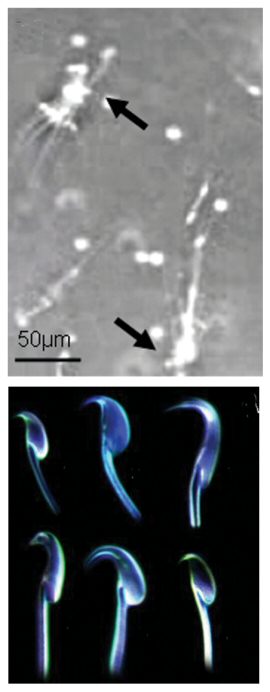25 January 2007
Rodent Sperm Cooperate For Success
by Kate Melville
 Competition for successful fertilization is believed to strongly influence the design of sperm and the incredible variation of sperm appearance across species has long fascinated scientists. The functional significance of many sperm traits, however, is still poorly understood.
Competition for successful fertilization is believed to strongly influence the design of sperm and the incredible variation of sperm appearance across species has long fascinated scientists. The functional significance of many sperm traits, however, is still poorly understood.
But now, a new study by researchers from the UK and Australia has revealed a fascinating cooperative behavior in rodent sperm. In the European woodmouse Apodemus sylvaticus (Muridae), the highly reflected apical hook of sperm is used to form sperm groups, or "trains", which allow increased swimming velocity and thrusting force compared to individual sperm. Study leader, Dr Simone Immler, said that in promiscuous rodents, the "groups" of sperm are easily able to out-compete the individual sperm of rival males.
Typically, although sperm are ejaculated in their millions, each sperm goes it alone. It's likely that the cooperative behavior in woodmouse sperm has evolved through promiscuous females forcing males into an arms race so their sperm can compete against those of rival males.
Immler, from the University of Sheffield, says that this cooperation is possible only because of to the highly specialized design of rat and mouse sperm. Promiscuous species have a particularly well developed 'hook shaped' sperm head which helps individual sperm to hook up to each other and form a group. These groups of sperm contain between 5 and 100 sperm and they swim faster and stronger than individual sperm which makes them better competitors in the race for the fertilization of the egg.
"It was previously believed that sperm not only competed against rival males but that they also competed against each other in order to fertilize the female egg. However, this research shows that when the pressure from rival males is high, individual sperm will cooperate with one another to ensure that at least one of their siblings successfully reaches the female egg," concluded Immler.
Related articles:
Sperm Follow Their Noses
Promiscuous Females Make For Competitive Sperm
Source: Public Library of Science
Pic courtesy University of Sheffield
